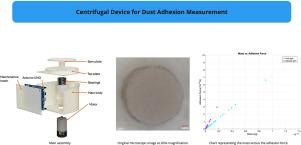粉尘附着力测量的离心装置
IF 2.1
Q3 ENGINEERING, ELECTRICAL & ELECTRONIC
引用次数: 0
摘要
本文详细介绍了为粘附测量量身定制的台式离心机的设计,施工和操作。该设备故意简单,利用广泛可用的组件,并专门采用3D打印作为制造方法。离心机便于分离力的测量,用户可调节的样品附着点通过接口或双面胶带。附着力由分离力和粉尘质量共同决定;为了达到这个目的,光学显微镜可以用来精确地测定尘埃质量。用户友好的图形界面允许输入所需的转速和持续时间,而内置的编码器和PID算法确保精确的操作。灰尘粘附对测量提出了重大挑战,该离心机通过紧凑的模块化设计解决了这些挑战,该设计包括四个3d打印组件,Arduino Uno,电源插座,接线,电机控制器,轴承,编码器配备的电机和塑料圆顶。用一组螺钉完成组装。该装置的主要应用是评估月球风化模拟物在不同材料上的分离力。然而,设计是通用的,可以适应光谱或作为一个紧凑的生物应用离心机。本文章由计算机程序翻译,如有差异,请以英文原文为准。

Centrifugal device for dust adhesion measurement
This article details the design, construction, and operation of a benchtop centrifuge tailored for adhesion measurements. The device is intentionally simple, leveraging widely available components and exclusively employing 3D printing as the manufacturing method. The centrifuge facilitates the measurement of detachment forces, with user-adjustable sample attachment points via an interface or double-sided tape. The adhesion force is determined by considering both the detachment force and the mass of the dust; to achieve this, optical microscopy may be employed to determine the dust mass accurately. A user-friendly graphical interface allows for the input of desired rotational speeds and durations, while a built-in encoder and PID algorithm ensure precise operation.
Dust adhesion presents significant challenges for measurement, and this centrifuge addresses these challenges through a compact, modular design comprising four 3D-printed components, an Arduino Uno, a power socket, wiring, a motor controller, bearings, an encoder-equipped motor, and a plastic dome. Assembly is completed with a set of screws.
The primary application of this device is to evaluate the detachment forces of lunar regolith simulants on various materials. However, the design is versatile and can be adapted for spectrometry or as a compact centrifuge for biological applications.
求助全文
通过发布文献求助,成功后即可免费获取论文全文。
去求助
来源期刊

HardwareX
Engineering-Industrial and Manufacturing Engineering
CiteScore
4.10
自引率
18.20%
发文量
124
审稿时长
24 weeks
期刊介绍:
HardwareX is an open access journal established to promote free and open source designing, building and customizing of scientific infrastructure (hardware). HardwareX aims to recognize researchers for the time and effort in developing scientific infrastructure while providing end-users with sufficient information to replicate and validate the advances presented. HardwareX is open to input from all scientific, technological and medical disciplines. Scientific infrastructure will be interpreted in the broadest sense. Including hardware modifications to existing infrastructure, sensors and tools that perform measurements and other functions outside of the traditional lab setting (such as wearables, air/water quality sensors, and low cost alternatives to existing tools), and the creation of wholly new tools for either standard or novel laboratory tasks. Authors are encouraged to submit hardware developments that address all aspects of science, not only the final measurement, for example, enhancements in sample preparation and handling, user safety, and quality control. The use of distributed digital manufacturing strategies (e.g. 3-D printing) is encouraged. All designs must be submitted under an open hardware license.
 求助内容:
求助内容: 应助结果提醒方式:
应助结果提醒方式:


